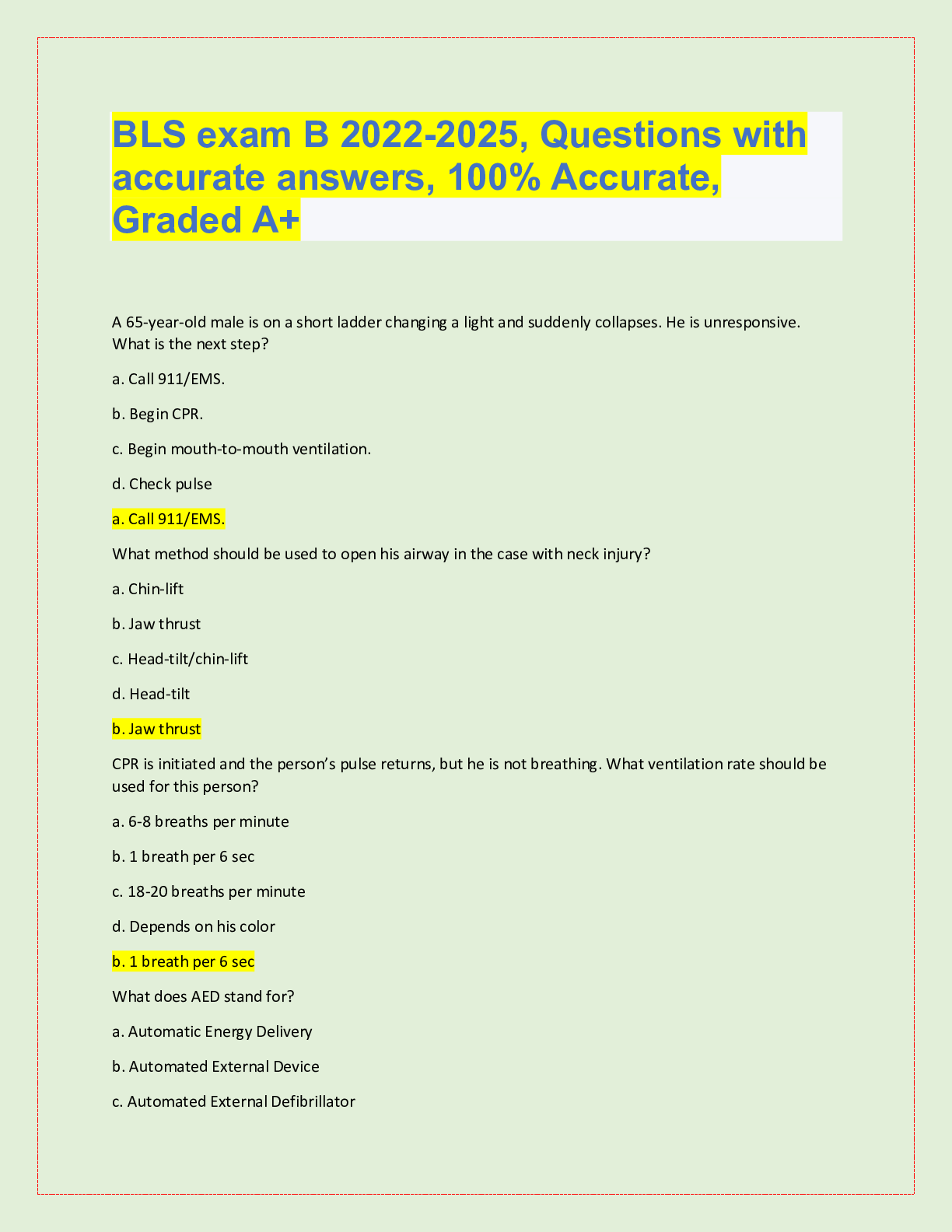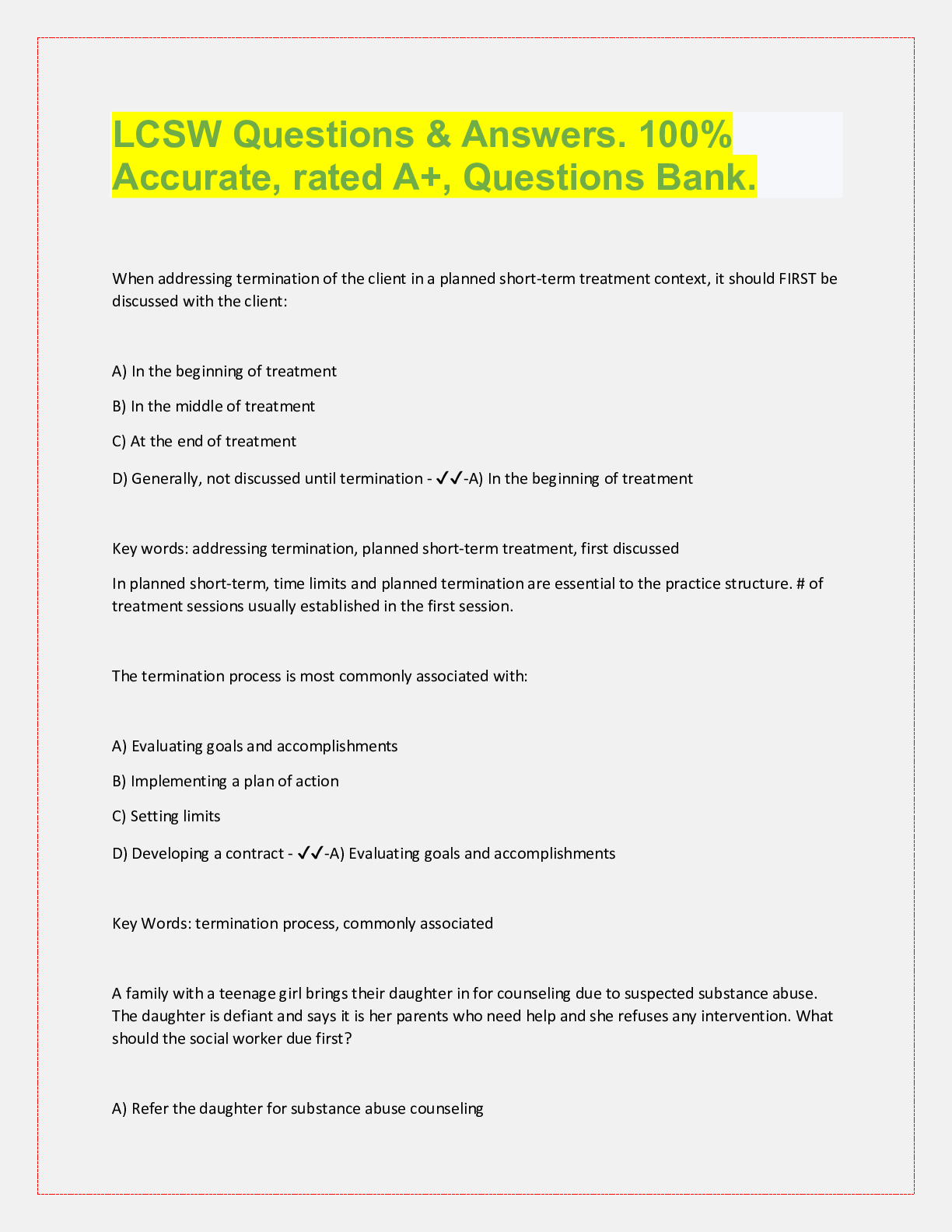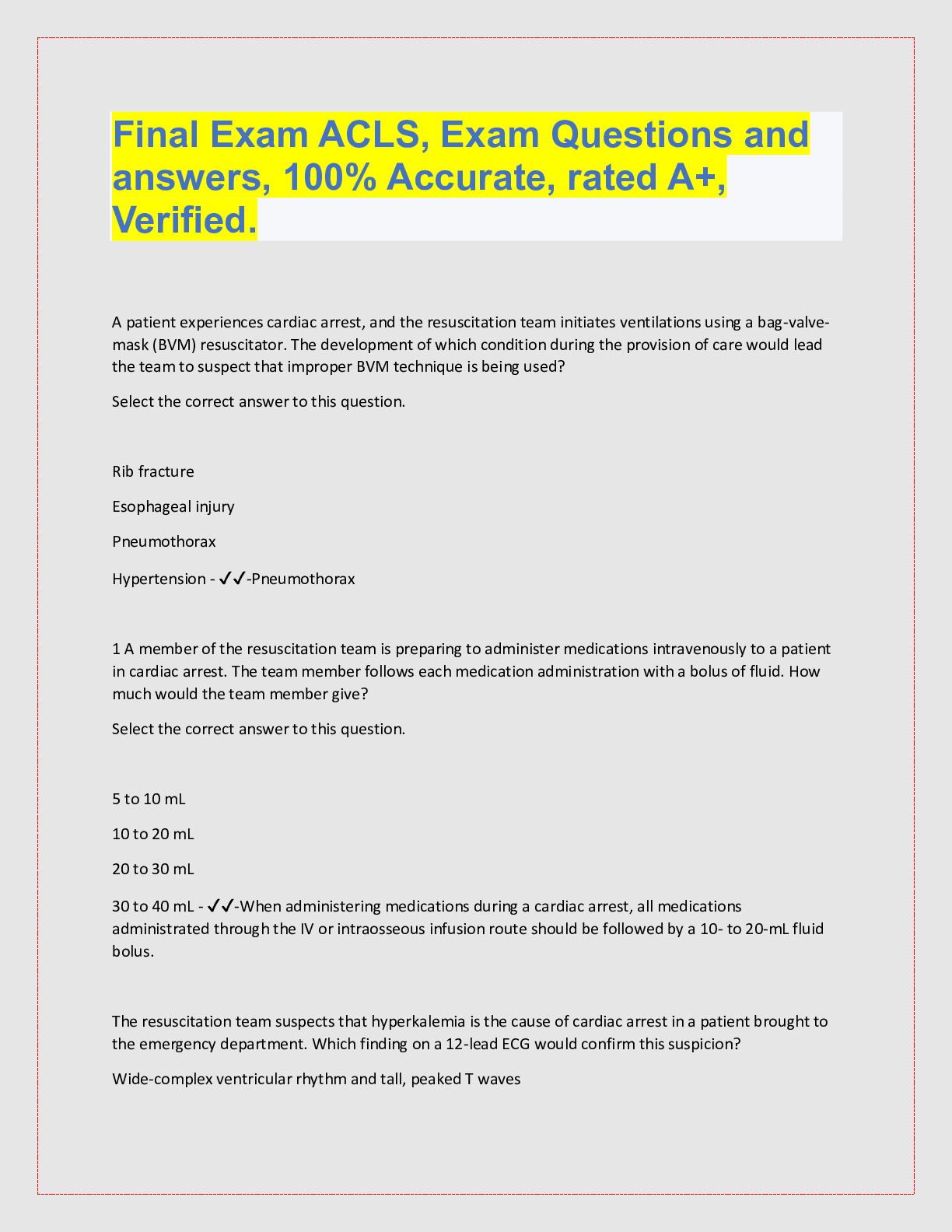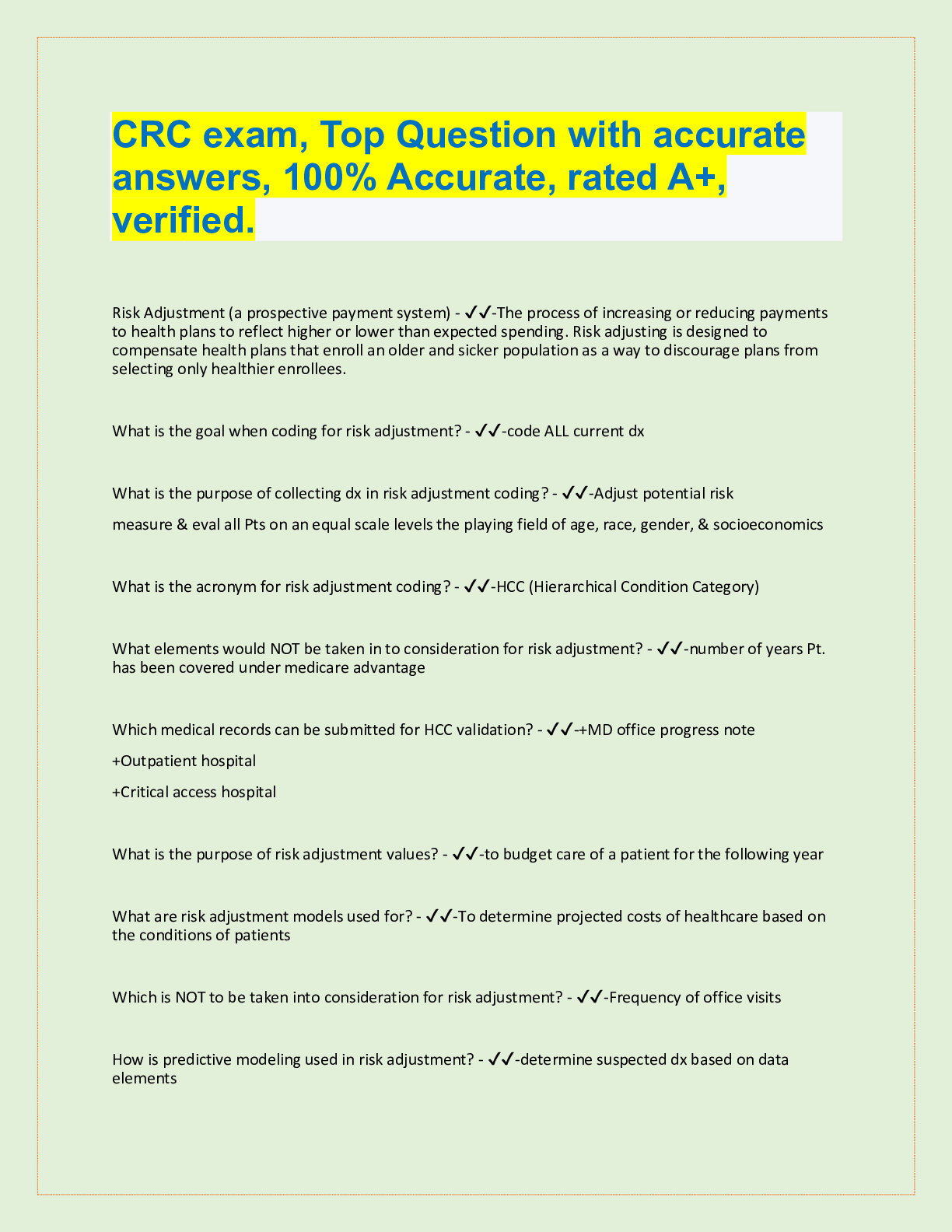*NURSING > QUESTIONS & ANSWERS > Adult Gerontology - ENT Q & A, 100% Accurate, Rated A+, 2022/2023. (All)
Adult Gerontology - ENT Q & A, 100% Accurate, Rated A+, 2022/2023.
Document Content and Description Below
Adult Gerontology - ENT Q & A, 100% Accurate, Rated A+, 2022/2023. Which of the following refractive errors in vision is a result of the natural loss of accommodative capacity with age? A. ... Presbyopia B. Hyperopia C. Myopia D. Astigmatism - ✔?Answer: A Painless, white, slightly raised patches in client's mouth are probably caused by candidiasis (thrush). Aphthous ulcers (canker sores) are extremely painful. Herpes simplex (a viral infection), canker sores, and cancerous lesions are usually discrete and not spread over a large area. Alexandra, age 34, was treated with oral antibiotics 2 weeks ago for a urinary tract infection. She is seen in the office today for a follow-up visit. On physical examination, the nurse practitioner notices that she has some painless, white, slightly raised patches in her mouth. This is probably caused by A. herpes simplex. B. aphthous ulcers. C. candidiasis. D. oral cancer. - ✔?Answer: C Painless, white, slightly raised patches in a client's mouth are probably caused by candidiasis (thrush). Aphthous ulcers (canker sores) are extremely painful. Herpes simplex (a viral infection), canker sores, and cancerous lesions are usually discrete and not spread over a large area. The antibiotic of choice for recurrent acute otitis media and/or treatment failure in children is A. amoxicillin (Amoxil). B. amoxicillin and potassium clavulanate (Augmentin). C. azithromycin (Zithromax). D. prednisone (Deltasone) - ✔?Answer: B The antibiotic of choice for recurrent acute otitis media (AOM) or treatment failure is amoxicillin and potassium clavulanate (Augmentin). Amoxicillin (Amoxil) is used as the first-line treatment of AOM. However, it is not used in patients with recurrent AOM or treatment failure. Azithromycin (Zithromax) for otitis media is usually reserved for patients with penicillin allergy. Prednisone (Deltasone) is not an antibiotic. Kevin, a 56-year-old lawyer, has throbbing pain in the left eye, an irregular pupil shape, marked photophobia, and redness around the iris. What is your initial diagnosis? A. Conjunctivitis B. Iritis C. Subconjunctival hemorrhage D. Acute glaucoma - ✔?Answer: B If a client has throbbing pain in the eye, an irregular pupil shape, marked photophobia, and redness (a deep, dull, red halo or ciliary fl ush) around the iris and/or cornea, suspect iritis. An immediate referral is warranted. The client may also have blurred vision. The client with conjunctivitis has redness more prominently at the periphery of the eye, along with tearing and itching. The client may also complain of a scratchy, burning, or gritty sensation but not pain, although photophobia may be present. The client with subconjunctival hemorrhage presents with a sudden onset of a painless, bright-red appearance on the bulbar conjunctiva that usually results from pressure exerted during coughing, sneezing, or Valsalva maneuver. Other conditions that may result in a subconjunctival hemorrhage include uncontrolled hypertension and the use of anticoagulant medication. The client with acute glaucoma presents with circumcorneal redness, with the redness radiating around the iris, and a dilated pupil. Marvin, 76-years-old, has sudden eye redness that occurred after a strenuous coughing episode. You diagnose a subconjunctival hemorrhage. Your next step is to A. refer him to an ophthalmologist. B. order antibiotics. C. do nothing other than provide teaching and reassurance. D. consult with your collaborating physician. - ✔?Answer: C There is no treatment for a subconjunctival hemorrhage other than to teach and reassure the client that the blood will be reabsorbed within 2 weeks. The most common cause of sensorineural hearing loss is A. trauma. B. tympanic membrane sclerosis and scarring. C. otosclerosis. D. presbycusis. - ✔?Answer: D The most common cause of sensorineural hearing loss is presbycusis, a gradual decrease in cochlear function that occurs in most persons with advancing age. Otosclerosis (stapes fi xation) and tympanic membrane sclerosis and scarring both result in a conductive hearing loss. Trauma would also result in a conductive hearing loss. Mattie, age 64, presents with blurred vision in one eye and states that it felt like "a curtain came down over my eye." She doesn't have any pain or redness. What do you suspect? A. Retinal detachment B. Acute angle-closure glaucoma C. Open-angle glaucoma D. Cataract - ✔?Answer: A The classic sign of retinal detachment is a client stating that "a curtain came down over my eye." Typically, the person presents with blurred vision in one eye that becomes progressively worse, with no pain or redness. With acute angle-closure glaucoma, there is a rapid onset in older adults, with severe pain and profound visual loss. The eye is red, with a steamy cornea and a dilated pupil. With open-angle glaucoma, there is an insidious onset in older adults, a gradual loss of peripheral vision over a period of years, and perception of "halos" around lights. With a cataract, there is blurred vision that is progressive over months or years and no pain or redness. You are the nurse practitioner caring for Martha, a 47-year-old accountant. You have made a diagnosis of acute sinusitis based on Martha's history and the fact that she complains of pain behind her eye. Which sinuses are affected? A. Maxillary B. Ethmoid C. Frontal D. Sphenoid - ✔?Answer: B With ethmoid sinus problems, the pain is behind the eye and high on the nose. Maxillary sinus pain is over the cheek and into the upper teeth; frontal sinus pain is over the lower forehead; and sphenoid sinus pain is in the occiput, vertex, or middle of the head. The most frequent cause of laryngeal obstruction in an adult is A. a piece of meat. B. a tumor. C. mucosal swelling from an allergic reaction. D. inhalation of a carcinogen. - ✔?Answer: A The most frequent cause of laryngeal obstruction in an adult is a piece of meat that lodges in the airway. With a tumor, there would be a gradual growth, and treatment would probably be sought before there is a complete obstruction. Mucosal swelling from an allergic reaction may result in an obstruction, but this does not occur as frequently as a laryngeal obstruction from a piece of meat. Inhalation of a carcinogen would result only in an irritation of the mucosa, if anything. Henry, 64 years old, is having difficulty getting rid of a corneal infection. He asks you why. How do you respond? A. "We can't determine the causative agent." B. "Systemic antibiotics have diffi culty getting to that area of the eye." C. "Because the infection was painless, it was not treated early enough." D. "Because the cornea doesn't have a blood supply, an infection can't be fought off as usual." - ✔?Answer: D Because the cornea is an avascular organ, immune defenses have difficulty fighting off infections. "We can't determine the causative agent" is not a satisfactory answer to give a patient. Even if the causative agent were identified, systemic antibiotics would still not be effective in most cases. Earlier treatment would also not increase the rate of healing. Which of the following is not a normal sensory deficit associated with aging? A. Gradual decline in sense of taste B. Hearing loss of high-frequency tones C. Decline in sense of proprioception D. Loss of all peripheral vision - ✔?Answer: D A narrowed field of vision may be experienced by some older patients, but a complete loss of peripheral vision is not a normal sensory loss in the aging adult. Additional visual deficits common to the aging adult are deficits in reading fine print (presbyopia), an increased sensitivity to light, and decreased night vision. Gradual decline in sense of taste, hearing loss of high-frequency tones, and decline in sense of proprioception are all normal aspects of the aging process. Millie, a well-nourished 69-year-old retired widow, presents to the office for her routine physical examination and states that in the past month she has had two nosebleeds. The episodes were mild and self -limiting. Her past medical history is unremarkable. She does not take any anticoagulants, and you have ruled out any coagulopathies. The most likely cause of these nosebleeds is A. local trauma. B. sex hormones. C. a dietary change. D. scurvy. - ✔?Answer: A The most common reason for epistaxis is a local irritation or trauma (90%). It would be helpful to ask if the patient bumped her nose or recently had a sinusitis or irritation to the mucosa that may have predisposed her to the nosebleed. Nosebleeds and bruising are common with elderly patients who are taking an anticoagulant; however, this patient is not taking any anticoagulants. Unless the patient diet is severely lacking in vitamin K, there is no need for her to change her diet. Severe vitamin C deficiency (scurvy) can cause bleeding; however, the condition is very rare in the United States. A common, age-related, gradual, and progressive hearing loss in adults age 65 and older is called A. noise-induced hearing loss. B. otitis media. C. presbycusis D. otosclerosis - ✔?Answer: C Presbycusis is the loss of hearing that gradually occurs in most individuals as they grow older. It is a common hearing disorder associated with aging. It is estimated that approximately 30 to 35 percent of adults age 65 and older have a hearing loss. Noise-induced hearing loss is caused by exposure to loud noise and can affect individuals of all ages. Otitis media (OM) is an infection of the middle ear, usually caused by bacteria. Anyone can get an ear infection, but it is far more common in children. Otosclerosis is caused by abnormal bone remodeling in the middle ear. It is estimated that 10 percent of the adult Caucasian population is affected. It can begin at any time between the ages of 15 and 45 but usually starts in the early twenties. Marlene, a 57-year-old cashier, comes to the clinic because she is unable to differentiate between sharp and dull stimulation on both sides of her face. You suspect A. Bell's palsy. B. a lesion affecting the trigeminal nerve. C. a stroke (brain attack, CVA). D. shingles. - ✔?Answer: B Bell's palsy affects the facial nerve, resulting in weakness or paralysis of one side of the face. A stroke and shingles are unilateral in their presentation as well. A lesion affecting the sensory portion of the trigeminal nerve could be manifested by bilateral symptoms Kimberly, a 17-year-old high school student, was hit in the right eye with a tennis ball. She developed pain in the eye, decreased visual acuity, and injection of the globe. You confirm the diagnosis of hyphema by finding blood in the anterior chamber. Which of the following treatments should the nurse practitioner not recommend while Kimberly is waiting to see the ophthalmologist? A. Apply an eye shield to the affected eye. B. Rest in bed with the HOB elevated. C. Take aspirin 650 mg every 6 hours as needed. D. Avoid strenuous activities. - ✔?Answer: C The treatment for hyphema is strict bedrest, with the head elevated at least 20°, application of an eye patch to the affected eye to minimize eye movement, and avoiding strenuous activities. The administration of aspirin is contraindicated to prevent additional bleeding. Jonathan, age 19, has just been given a diagnosis of mononucleosis. Which of the following statements is true? A. The offending organism is bacteria and should be treated with antibiotics. B. Convalescence is usually only a few days, and Jonathan should be back to normal in a week. C. Mononucleosis is rarely contagious. D. Jonathan should avoid contact sports and heavy lifting. - ✔?Answer: D When teaching clients about mononucleosis (EBV), tell them to avoid contact sports and heavy lifting, because of splenomegaly and a threat of rupture. Also instruct the patient to avoid stress and advise that convalescence may take several weeks. Antibiotic therapy is not indicated for EBV. The virus that causes mononucleosis is transmitted through the saliva, hence the nickname the "kissing disease." It is contagious and can be transmitted through kissing or sharing utensils. Bedrest is necessary only in severe cases. A 65-year-old man presents complaining of a left-side, deep, throbbing headache along with mild fatigue. On examination the client has a tender, tortuous temporal artery. You suspect giant cell arteritis (temporal arteritis). What is the least invasive procedure to help with diagnosis? A. MRI of the head B. Erythrocyte sedimentation rate (ESR) C. EEG D. Otoscopy - ✔?Answer: B An elevated ESR—anywhere from 30 to 100 mm/hr—may be seen in giant cell arteritis (temporal arteritis); however, the ESR may also be normal. The temporal artery supplies the optic nerve; if temporal arteritis is suspected due to the age of the client (50 and older) and the location and character of the pain, it is essential that a referral to a surgeon be made for immediate biopsy of the artery before damage to the optic nerve occurs. An MRA, not MRI, can be done to evaluate the blood vessels in the brain, but the blood test is less invasive. EEG and otoscopy are not used in the diagnosis of GCA. A temporal artery biopsy (TAB), an invasive procedure, is the criterion standard for diagnosing temporal arteritis. Sylvia, age 72, has glaucoma and has started taking a medication that acts as a diuretic to reduce the intraocular pressure. Which medication is she taking? A. A carbonic anhydrase inhibitor B. A beta-adrenergic receptor blocker C. A miotic D. A mydriatic - ✔?Answer: A Carbonic anhydrase inhibitors, such as acetazolamide (Diamox), act as diuretics to reduce the intraocular pressure in clients with glaucoma. A miotic causes contraction of the pupil, and a mydriatic dilates the pupil. Because of the effect of pupil dilation on aqueous outflow in angle-closure glaucoma, medications such as atropine and other anticholinergics that have a mydriatic effect should be avoided. Miotics such as pilocarpine (Pilocar) may be given to cause contraction of the sphincter of the iris and to contract the ciliary muscle, which promotes accommodation for near vision and facilitates aqueous humor outflow by increasing drainage through the trabecular meshwork in openangle glaucoma. But the question is asking about diuretics, which pilocarpine is not. It is a cholinergic agent. When you are assessing the internal structure of the eye of your 59-year-old patient, the absence of a red reflex may indicate A. a cataract or a hemorrhage into the vitreous humor. B. acute iritis. C. nothing; this is a normal finding in older adults. D. diabetes or long-standing hypertension. - ✔?Answer: A When assessing the internal structure of the eye, absence of a red reflex may indicate the total opacity of the pupil because of a cataract or a hemorrhage into the vitreous humor. It may also be a result of improper positioning of the ophthalmoscope. Acute iritis is noted by constriction of the pupil accompanied by pain and circumcorneal redness (ciliary flush). If areas of hemorrhage, exudate, and white patches are present when the internal structure of the eye is assessed, they are usually a result of diabetes or long-standing hypertension Sharon, a 47-year-old bank teller, is seen by the nurse practitioner in the office for a red eye. You are trying to decide between a diagnosis of conjunctivitis and iritis. One distinguishing characteristic between the two is A. eye discomfort. B. slow progression. C. a ciliary flush. D. no change in or slightly blurred vision. - ✔?Answer: C When trying to decide between a diagnosis of conjunctivitis and iritis, one of the distinguishing characteristics is a ciliary flush present in iritis. Photophobia is not usually present in conjunctivitis, but it is always present with iritis. Photophobia occurs with corneal inflammation, iritis, and angle-closure glaucoma. Clients with iritis and those with conjunctivitis both complain of eye discomfort, although in iritis the pain is moderately severe with intermittent stabbing. Both conditions generally produce a slowly progressive redness. Vision is normal with conjunctivitis and blurred with iritis. The first-line antibiotic therapy for an adult with no known allergies and suspected group A beta-hemolytic streptococcal pharyngitis is A. penicillin. B. erythromycin (E-Mycin). C. azithromycin (Zithromax). D. cephalexin (Kefl ex). - ✔?Answer: A Penicillin (PCN) is the fi rst-line antibiotic therapy for an adult with no known allergies and suspected group A beta-hemolytic streptococcus pharyngitis. Erythromycin (E-Mycin) and azithromycin (Zithromax) are macrolide antibiotics and are recommended in individuals who have a penicillin allergy. Cephalexin (Kefl ex) is a cephalosporin antibiotic and has been found to be very effective in the treatment of strep throat and is a reasonable alternative to penicillin. Martin, age 24, presents to the office with an erythematous ear canal and pain on manipulation of the auricle. He is on vacation and has been swimming daily at the resort. What is your diagnosis? A. Acute otitis media B. Chronic otitis media C. External otitis D. Temporomandibular joint syndrome - ✔?Answer: C Penicillin (PCN) is the fi rst-line antibiotic therapy for an adult with no known allergies and suspected group A beta-hemolytic streptococcus pharyngitis. Erythromycin (E-Mycin) and azithromycin (Zithromax) are macrolide antibiotics and are recommended in individuals who have a penicillin allergy. Cephalexin (Kefl ex) is a cephalosporin antibiotic and has been found to be very effective in the treatment of strep throat and is a reasonable alternative to penicillin. While doing a face, head, and neck examination on a 16-year-old patient, you note that the palpebral fissures are abnormally narrow. What are you examining? A. Nasolabial folds B. The openings between the margins of the upper and lower eyelids C. The thyroid gland in relation to the trachea D. The distance between the trigeminal nerve branches - ✔?Answer: B The palpebral fissures are the openings between the margins of the upper and lower eyelids. Someone who appears to be squinting is said to have narrow palpebral fissures. The nasolabial folds are the skin creases that extend from the angle of the nose to the corner of the mouth. The thyroid is a butterfly-shaped gland located in the front of the neck just below the Adam's apple and is wrapped around the trachea. The trigeminal nerve is the fifth cranial nerve located within the brain. It is composed of three branches—the ophthalmic, maxillary, and mandibular—and is primarily responsible for transmitting sensations from the face to the brain. It is also the nerve that controls the muscles used for chewing. When the Weber test is performed with a tuning fork to assess hearing and there is no lateralization, the nurse practitioner should document this finding as A. conductive deafness. B. perceptive deafness. C. a normal finding. D. nerve damage. - ✔?Answer: C A Weber test assesses hearing by bone conduction. With normal hearing, sound is heard equally well in both ears, meaning there is no lateralization. With conductive deafness, sound lateralizes to the defective ear because it is transmitted through bone rather than air. With perceptive deafness, sound lateralizes to the better ear. Damage to CN VIII (vestibulocochlear nerve) causes symptoms of hearing loss, vertigo, and loss of equilibrium. Which of the following symptom(s) is (are) most indicative of mononucleosis (Epstein-Barr virus)? A. Rapid onset of anterior cervical adenopathy, fatigue, malaise, and headache B. Gradual onset of fatigue, posterior cervical adenopathy, fever, and sore throat C. Gradual and seasonal onset of pharyngeal erythema D. Rapid onset of cough, congestion, and headache - ✔?Answer: B Symptoms most indicative of mononucleosis (Epstein-Barr virus) are gradual onset of fatigue, sore throat, fever, posterior cervical adenopathy, palatine petechiae, and hepatosplenomegaly. Barbara, age 72, states that she was told she had atrophic macular degeneration and asks you if there is any treatment. How do you respond? A. "No, but 5 years from the time of the first symptoms, the process usually stops." B. "Yes, there is a surgical procedure that will cure this." C. "If we start medications now, they may prevent any further damage." D. "Unfortunately, there is no effective treatment, but I can refer you to a rehabilitation agency that can help you adjust to the visual loss." - ✔?Answer: D Currently, there is no effective treatment for atrophic macular degeneration. Laser photocoagulation may slow the exudative form of macular degeneration if performed early in the course of the disease. It seals leaking capillaries and stops the exudation. Clients cope with the disease by using large-print books and magazines, magnifying glasses, and high-intensity lighting. Mr. Cox, age 72, is brought to the office by his son, who states that his father has been unable to see clearly since last night. Mr. Cox reports that his vision is "like looking through a veil." He also sees floaters and flashing lights but is not having any pain. What do you suspect? A. Cataracts B. Glaucoma C. Retinal detachment D. Iritis - ✔?Answer: C A client with retinal detachment complains of a sudden change in vision (either blurry vision, flashing lights, or fl oaters) but has no pain. On ophthalmoscopy, the retina appears pale and opaque and folds in and undulates freely as the eye moves. Retinal detachment is an emergency and requires immediate surgery, usually scleral buckling, in which an encircling silicon band is used to keep the choroid in contact with the retina to promote attachment. Iritis is characterized by severe pain. Cataracts and most cases of glaucoma usually present as a gradual change in vision, not a sudden change. Microtia refers to the size of the A. ears. B. head. C. jaw. D. eyes. - ✔?Answer: A Microtia refers to the size of the ears, specifi cally ears smaller than 4 cm vertically. Microcephaly is an abnormally small head due to failure of brain growth. Micrognathia is a term for a lower jaw that is smaller than normal, and microphthalmia is a disorder in which one or both eyes are abnormally small. A 25-year-old client who plays in a band complains that he finds it difficult to understand his fellow musicians at the end of a night of performing, a problem that is compounded by the noisy environment of the club. These symptoms are most characteristic of which of the following? A. Sensorineural loss B. Conductive loss C. Tinnitus D. Vertigo - ✔?Answer: A Sensorineural loss comes from exposure to loud noises, inner ear infections, tumors, congenital and familial disorders, and aging. The etiology of conductive loss includes ear infection, presence of a foreign body, perforated drum, and otosclerosis of the ossicles. The results of the Weber and Rinne test will assist in the diagnosis. Tinnitus is ringing in the ears, and vertigo is dizziness associated with inner ear dysfunction. The client does not complain of either of these symptoms. Jill, a 34-year-old bank teller, presents with symptoms of hay fever. She complains of nasal congestion, runny nose with clear mucus, and itchy nose and eyes. On physical assessment, you observe that she has pale nasal turbinates. What is your diagnosis? A. Allergic rhinitis B. Viral rhinitis C. Nasal polyps D. Nasal vestibulitis from folliculitis - ✔?Answer: A The symptoms of hay fever, also called allergic rhinitis, are similar to those of viral rhinitis but usually persist and are seasonal in nature. When assessing the nasal mucosa, you will observe that the turbinates are usually pale or violaceous because of venous engorgement with allergic rhinitis. With viral rhinitis, the mucosa is usually erythematous; and with nasal polyps, there are usually yellowish, boggy masses of hypertrophic mucosa. Nasal vestibulitis usually results from folliculitis of the hairs that line the nares. What is the easiest way to differentiate between otitis externa and otitis media? A. With otitis media, tender swelling is usually visible. B. With otitis media, there is usually bilateral pain in the ears. C. With otitis media, there is usually tenderness on palpation over the mastoid process. D. With otitis externa, movement or pressure on the pinna is extremely painful. - ✔?Answer: D The easiest way to differentiate between otitis externa and otitis media is that with otitis externa, movement or pressure on the pinna is extremely painful. With otitis externa, there may also be tender swelling of the outer ear canal. Bilateral pain in the ears is more suggestive of otitis externa. Clients with acute mastoiditis present with severe pain in, and, especially behind, the ear. Clients with allergic conjunctivitis have which type of discharge? A. Purulent B. Serous or clear C. Stringy and white D. Profuse mucoid or mucopurulent - ✔?Answer: B Clients with allergic conjunctivitis have a stringy, white discharge. Clients with bacterial conjunctivitis have a purulent discharge; those with viral conjunctivitis have serous or clear drainage and pre-auricular lymph node enlargement. A profuse mucoid or mucopurulent discharge is indicative of chlamydial conjunctivitis. You are assessing a middle-aged woman for a routine annual physical. Your findings include a smooth tongue. This may indicate A. a normal finding. B. alcohol abuse. C. a vitamin deficiency. D. nicotine addiction. - ✔?Answer: C A smooth tongue may result from a vitamin deficiency. Normally, the dorsal surface of the tongue is rough because of papillae. The ventral surface near the floor of the mouth is smooth and shows large veins. Although there are no specific symptoms of the tongue related to tobacco and alcohol use, people who smoke and or drink alcohol are at higher risk for oral cavity or oropharyngeal cancer. Marian, age 79, is at a higher risk than a middle-aged client for developing an eye infection because of which age-related change? A. Increased eyestrain [Show More]
Last updated: 2 years ago
Preview 1 out of 49 pages
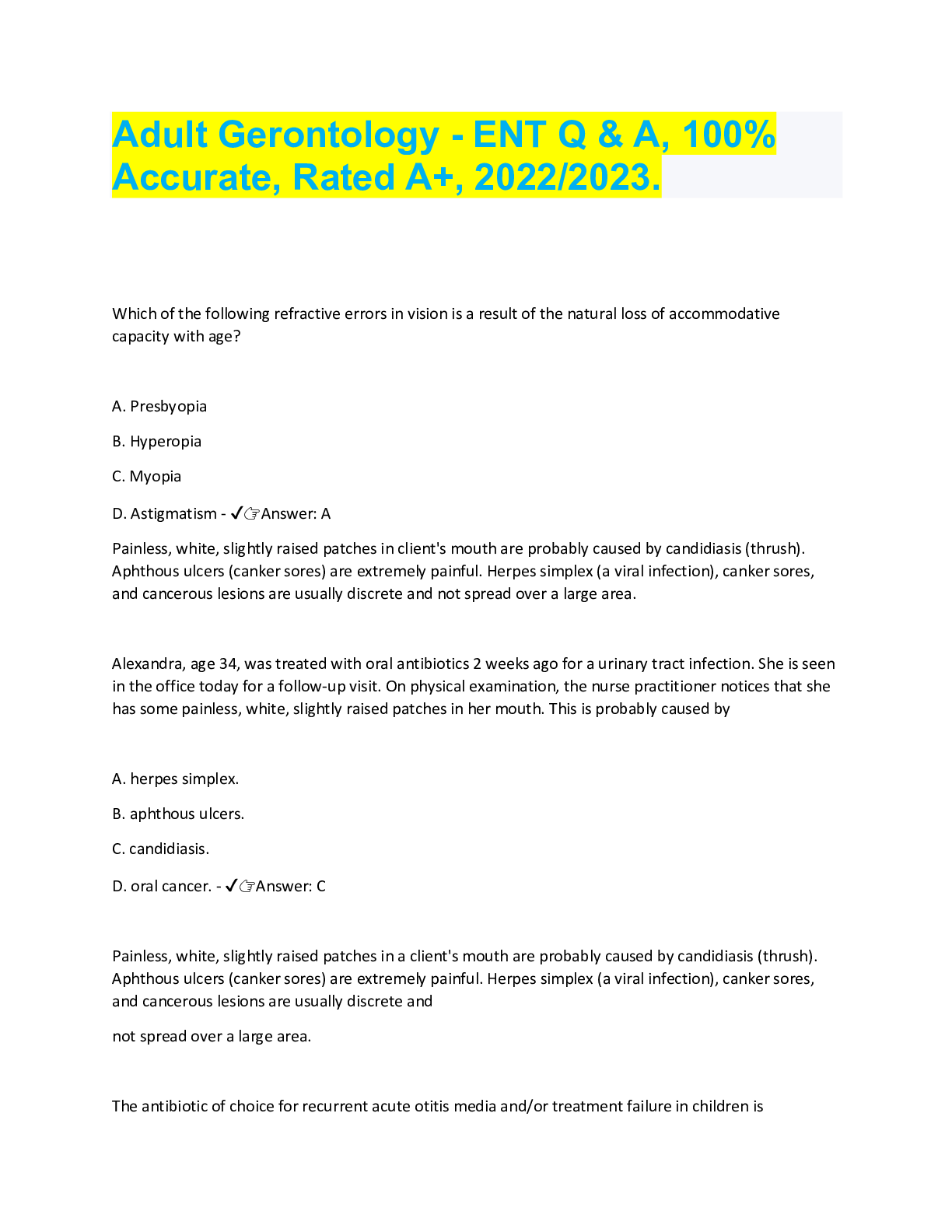
Buy this document to get the full access instantly
Instant Download Access after purchase
Buy NowInstant download
We Accept:

Reviews( 0 )
$12.00
Can't find what you want? Try our AI powered Search
Document information
Connected school, study & course
About the document
Uploaded On
Sep 24, 2022
Number of pages
49
Written in
Additional information
This document has been written for:
Uploaded
Sep 24, 2022
Downloads
0
Views
141

